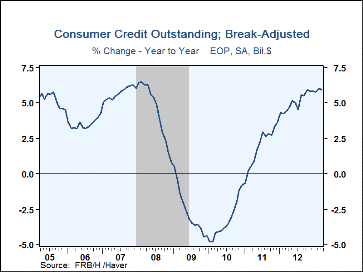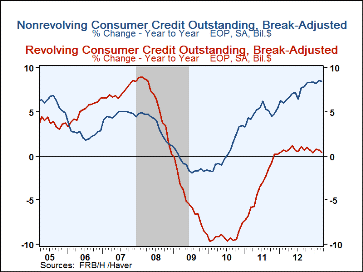 Global| May 07 2013
Global| May 07 2013U.S. Consumer Credit Growth Slackens, For Now
by:Tom Moeller
|in:Economy in Brief
Summary
Following many months of double-digit gains, consumer credit growth calmed down in March, according to the Federal Reserve. Nevertheless, the $8.0B monthly rise still left the annual gain close to its strongest since early-2008. The [...]
Following many months of double-digit gains, consumer credit growth calmed down in March, according to the Federal Reserve. Nevertheless, the $8.0B monthly rise still left the annual gain close to its strongest since early-2008. The increase surprised expectations for a gain of $15.0B, as measured by Action Economics.
Use of non-revolving credit eased although the $9.7B m/m gain left the y/y increase at 8.4%, its strongest since late-2002. Federal government loans rose nearly one quarter y/y, credit union lending rose 11.6% y/y, securitized loans increased 10.9% y/y and commercial bank loans gained 3.7% y/y. Borrowing from finance companies was nearly unchanged y/y. Non-revolving credit accounts for roughly two thirds of the credit total. In contrast, consumers remain less inclined to pull out their credit cards. Revolving credit fell $1.7B after a $0.4B February uptick. The y/y increase remained a minimal 0.5%. Savings institution loans rose 11.2% y/y and credit union lending increased 8.2% y/y. Pools of securitized assets rose 6.6% y/y. Commercial bank lending grew 1.4% y/y but borrowing from finance companies fell 12.5% y/y.
The figures used in this report are break-adjusted and calculated by Haver Analytics. There is a break in the credit outstanding data from November 2010 to December 2010 due to the Fed's benchmarking process. Benchmark estimates are based on the Census of Finance Companies (CFC) and the Survey of Finance Companies (SFC) conducted in 2010 and 2011, respectively. The consumer credit data are available in Haver's USECON database. The Action Economics figures are in the AS1REPNA database.
| Consumer Credit Outstanding (M/M Chg, SA | Mar | Feb | Jan | Y/Y | 2012 | 2011 | 2010 |
|---|---|---|---|---|---|---|---|
| Total | $8.0B | $18.6B | $12.7B | 5.9% | 5.8% | 3.7% | -0.7% |
| Revolving | -1.7 | 0.4 | 1.7 | 0.5 | 0.4 | 0.2 | -7.5 |
| Non-revolving | 9.7 | 18.2 | 11.0 | 8.4 | 8.4 | 5.5 | 3.4 |
Tom Moeller
AuthorMore in Author Profile »Prior to joining Haver Analytics in 2000, Mr. Moeller worked as the Economist at Chancellor Capital Management from 1985 to 1999. There, he developed comprehensive economic forecasts and interpreted economic data for equity and fixed income portfolio managers. Also at Chancellor, Mr. Moeller worked as an equity analyst and was responsible for researching and rating companies in the economically sensitive automobile and housing industries for investment in Chancellor’s equity portfolio. Prior to joining Chancellor, Mr. Moeller was an Economist at Citibank from 1979 to 1984. He also analyzed pricing behavior in the metals industry for the Council on Wage and Price Stability in Washington, D.C. In 1999, Mr. Moeller received the award for most accurate forecast from the Forecasters' Club of New York. From 1990 to 1992 he was President of the New York Association for Business Economists. Mr. Moeller earned an M.B.A. in Finance from Fordham University, where he graduated in 1987. He holds a Bachelor of Arts in Economics from George Washington University.








